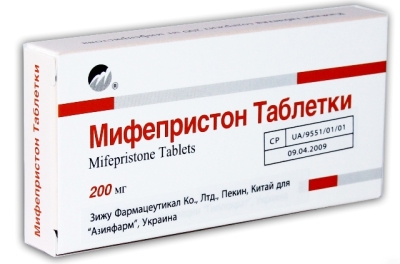Unwanted pregnancy in the early stages, what to do
Any woman who has begun to live a sexual life has a great opportunity to become pregnant and give birth to a child. But in certain situations, pregnancy is undesirable. The reason for this may be financial problems, a failed relationship with the future father, or maybe the woman simply does not want to take responsibility for the life of the baby. Be that as it may, the only right decision would be to give birth to a child and give it up to those who can really take care of him. If we talk about abortion (in other words, about abortion) in the early stages, then today there are many different ways. Let's consider them.
Two stripes - what to do?
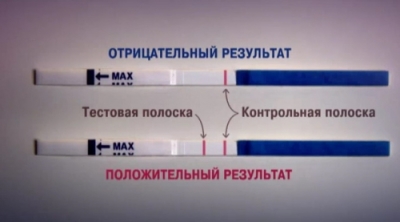

Even a previous test does not mean that a woman is actually pregnant. The fact is that many test strips are wrong - for example, if three tests were carried out, and two of them showed two strips, this can also be a mistake. But only a doctor can give an accurate confirmation of pregnancy.
 Only then should you start thinking about what to do next. If the child is unwanted, then many (mostly young girls) want to get rid of him, but without harm to health, in order to be able to become pregnant in the future.
Only then should you start thinking about what to do next. If the child is unwanted, then many (mostly young girls) want to get rid of him, but without harm to health, in order to be able to become pregnant in the future. 
Unwanted pregnancy in the early stages what to do: the main methods of termination
There are several ways, each of them has its own characteristics and disadvantages. The most common is curettage of the uterus.
Surgical interruption (curettage)
It is carried out no later than 12 weeks of pregnancy. This is done under anesthesia - epidural or intravenous (the method is chosen by the anesthetist based on physiological characteristics and contraindications). With the help of dilators, which are tubes of different diameters, the uterine cervix opens and an iron loop (curette) is inserted inside, through which the cleaning is carried out. This is a surgical procedure under anesthesia, so there is always a risk of complications. 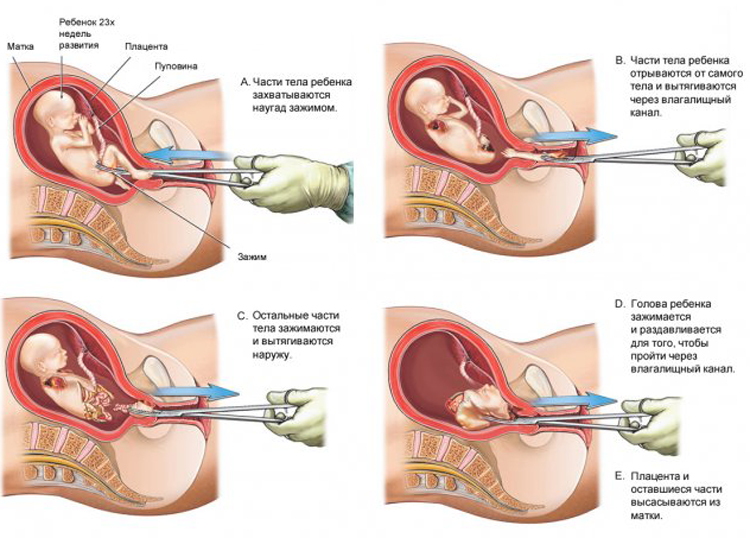
On a note! This risk can be reduced if, before / after the procedure, the uterine cavity is examined with a hysteroscope, and an ultrasound control is also performed using a vaginal probe.
One of the most serious complications is the perforation of the uterus, followed by entry into the abdominal cavity. The consequence of this is trauma to the organs, peritonitis or severe internal bleeding, which can even lead to death.
Video - Termination of pregnancy
This is called manual vacuum aspiration, or MVA for short. The technique is used at the initial stages (no later than 12 weeks) and consists in introducing a special syringe into the uterus to aspirate its contents.  In almost 98% of cases, MVA completely removes the fetus, which is why it can be used on an outpatient basis. Statistically, aspiration is safer than curettage and has fewer complications.
In almost 98% of cases, MVA completely removes the fetus, which is why it can be used on an outpatient basis. Statistically, aspiration is safer than curettage and has fewer complications.
On a note! In addition, MVA helps to prevent possible complications in case of incomplete abortion.
The procedure is as follows. First, the girl makes an appointment with a doctor who examines her and confirms the pregnancy. Then an ultrasound is assigned and the date of the abortion itself. In the process of aspiration, a vacuum aspirator is introduced into the uterus, through which the fetal egg is evacuated. Negative pressure is created in the vagina, as a result of which the fetus leaves the uterine cavity. 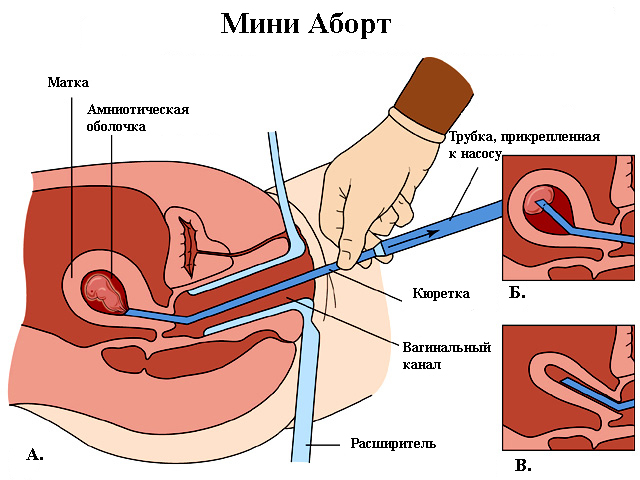
The procedure itself takes about 5 minutes, during which the woman is under general anesthesia. At the end of the procedure, a second ultrasound is prescribed, which will determine whether the fetal egg has been completely removed. If it was not completely removed, then a second cleaning is carried out. 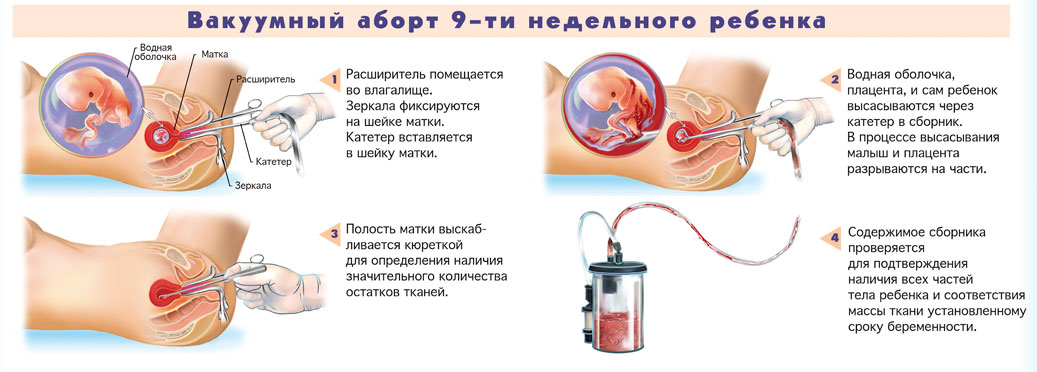
This method of abortion has its pros and cons. The first can be attributed to the fact that it is less aggressive than scraping. Among the minuses are prolonged pain in the lower abdomen at the end of the procedure, the possibility of a violation of the menstrual cycle and hormonal levels.
Termination of pregnancy with pills has become increasingly popular in recent years. But it is worth remembering that this method is effective only in cases where the period does not exceed 8 weeks. If the period is longer, then you can not do without medical help.
This drug, being an antiprogestin, is used for abortions at less than 49 days' gestation. Doses may vary. For example, in European countries it is 600 ml orally, although recent studies have shown that 200 ml is quite sufficient. Approximately 1.5-2 days after taking mifepristone, prostaglandin is used. According to the same studies, the combination of these drugs allows you to achieve a complete abortion in 94% of cases. 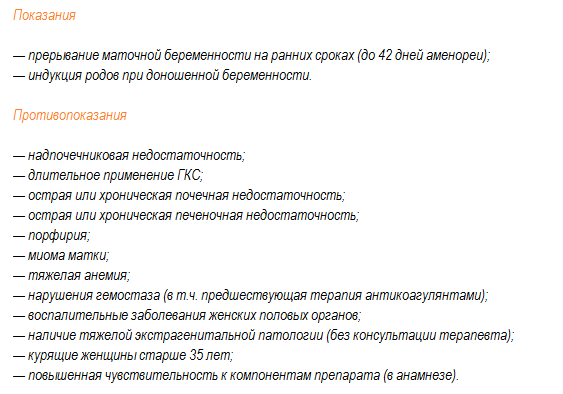
Side effects include:
- nausea;
- prolonged bleeding;
- diarrhea;
- vomiting.
On a note! Despite all the advantages of this method, it is widely used in healthcare in only one country - China.
This drug, related to antimetabolites, prevents cell division; it has long been used in the treatment of ectopic pregnancy (its effectiveness exceeded 90%). Not so long ago, it also began to be used to terminate pregnancy in the initial stages. If the period does not exceed 49 days, then methotrexane is administered intramuscularly at the rate of 50 mg per square meter of body surface. Approximately 6-7 days after ingestion, 800 micrograms of misoprostol is injected into the vagina. 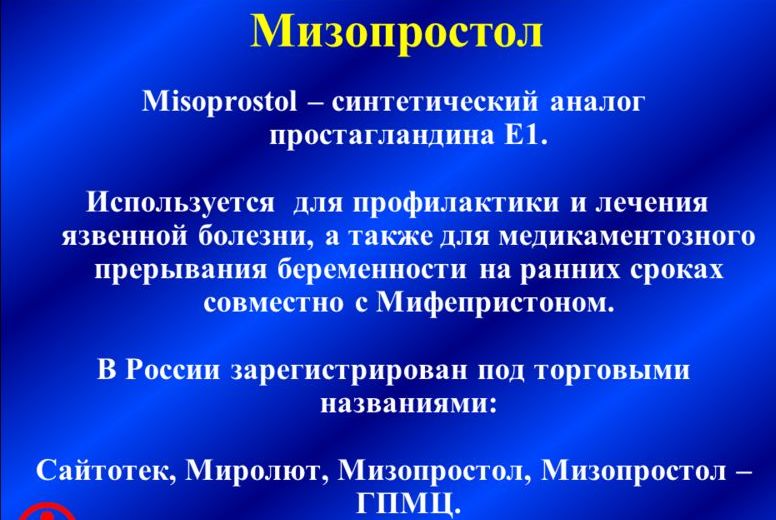
Side effects include:

We also add that WHO is categorically against the use of methotrexate, given the possible defects in newborns. After all, about 10% of interruptions are unsuccessful, and any surgical intervention is often no longer possible. Therefore, WHO experts do not recommend this drug for abortion.
On a note! There is also misoprostol, but it is used only in the 2nd and 3rd trimesters. In addition, it is used after a failed abortion (in other words, a miscarriage) to completely remove the fetal egg from the vagina.
Video - Medical abortion
Folk means of interruption
We’ll make a reservation right away that it’s better to contact a gynecologist, because only he will be able to have an abortion with minimal consequences.
From the first days after conception, radical changes occur in the body, mainly hormonal. And women who want to terminate a pregnancy using folk remedies should understand that this is harmful, and sometimes even dangerous. In particular, this applies to young girls who are embarrassed to contact a gynecologist or tell their parents.
On a note! It is much more difficult to ensure the normal development of the fetus than to terminate a pregnancy. But, alas, many do not understand this.
The most popular among folk methods are the following.

There are also other plants that have abortive properties. They lead to contraction of the uterine muscles and expulsion of the fetus. But almost all of these plants are poisonous and cause great harm to the liver and kidneys.

In addition, a decoction of flattened club grass, tricolor gentian and marsh wild rosemary is used. But we note that if a woman still decides to terminate the pregnancy, then a safer option is medical abortion.
Even the first and only termination of pregnancy can have the most serious consequences, including infertility. And if a woman has already had abortions before, then another interruption can be dangerous for the desired pregnancy! 
It is much easier to use contraceptive methods. And for those who already have several abortions behind them, it is advisable to consult a gynecologist or a psychologist (or better, both).
Reliability of methods of contraception
| Method of contraception | Degree of reliability, % |
|---|---|
| interrupted intercourse | 80-85 |
| Calendar method (“safe days” method)* | 80-90 (with a regular cycle) |
| Method for measuring basal body temperature* | 80-90 (with a regular cycle) |
| Vaginal douching | 10-15 |
| Condom | 90-95 |
| Diaphragm (vaginal cap) | 90-95 |
| Intrauterine devices (spirals) | 90-92 |
| Hormonal intrauterine devices (spirals) | 90-97 |
| Chemical contraception (creams, suppositories, tampons) | 79-90 |
| Hormonal pills (oral contraception) | 96,5-97 |
| Hormonal injections | 96,5-97 |
| Hormonal implants | 99-99,8 |
| Hormonal ring NovaRing | 99,4 |
| Medical sterilization | 99,8-99,9 |
And the last thing: abortion is a serious stress for the body and the inevitable price for the neglect of contraceptives. And none of the described methods is completely safe - even with excellent individual tolerance, the consequences can be the most deplorable. So is it worth changing for this such happiness as the birth of a child? The answer is obvious.


